Revisiting the Planet of the Apes
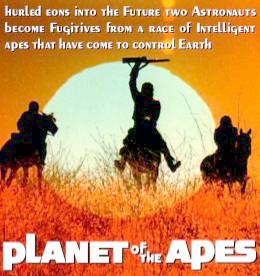
A promotional flyer for the Planet of the Apes television series
As a child of the 1970’s, I had the great pleasure of living through the original saga of the Planet of the Apes, including four sequels, two television series, and more merchandise than could probably ever be properly cataloged. The Apes phenomenon was similar to Star Trek in that it was not during its original theatrical run that its real popularity occurred. Obviously the films were successful at the box office or 20th Century Fox would not have continued to churn out almost annual installments but it wasn’t until these films began to play on network television a few years later that true Ape-mania began to sweep to the country. With an in-name only, re-imaging, cash-in film currently in theaters, it seems like an appropriate time to revisit the Planet of the Apes.
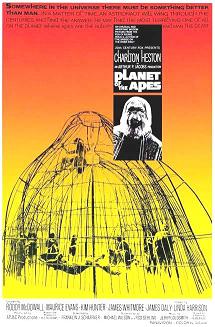
Planet of Apes
Planet of the Apes (1968) – Based on a novel by French author Pierre Boulle (originally titled Monkey Planet) and honed into a screen play by none other than legendary American writer Rod Serling, the inaugural installment in the Apes franchise packs a punch that can still be felt all these years later. Nihilistic astronaut George Taylor (perfectly portrayed by Charlton Heston) hasn’t so much left his overpopulated home world of Earth as he has abandoned it to seek peace and quiet elsewhere in the stars. In a turn of bitter irony, he ends up the sole representative of his species in a civilization that makes the one he left behind look a paradise by comparison. Fortunately Taylor is able to find a few allies amongst the apes in the form of sympathetic chimpanzees Cornelius and Zira but he is persecuted by the pampas orangutan Dr. Zaius, who has an almost manic fear of what an intelligent human might mean to his society, and he is hunted by the gorilla enforcers. Taylor’s hard won freedom at the film’s finale is marred by one of the greatest twists in cinematic history when he discovers that he has been home all along and the hell he has just experienced was the end result of his own species’ shortcomings.
20th Century Fox took a tremendous gamble making the first Apes film. The studio was experiencing financial difficulties due to the failure of several recent big budget films and if this one failed it could have put them out of business. On the strength of actor Charlton Heston playing the lead role and a rather unimpressive screen test of makeup that was far inferior to what ended up in the final film, they decided to take the considerable risk. With noted exception to Mr. Heston, the real stars of the film were character actors Roddy McDowall, Kim Hunter, and Maurice Evens as the lead apes in John Chambers’ wonderful (and Oscar winning) makeup. It was these human actors who were able to make intelligent apes seem believable to late 60’s theater audiences and without that there would be no legacy to discuss today.
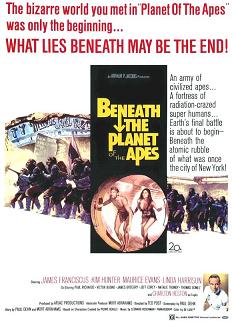
Beneath The Planet of Apes
Beneath the Planet of the Apes (1970) – The original Planet of the Apes film had posed more questions than it had answered so there was plenty of cloth left over to fashion a sequel from. What Fox lacked though was actor Charlton Heston, who was strongly opposed to returning, and the foresight to increase the budget based on the previous film’s box office performance. Luckily Heston relented and agreed to what was supposed to be only a cameo appearance but ended up significantly extended. After Taylor disappears in the Forbidden Zone in the first few minutes of the film, the only survivor of a rescue mission from Earth (John Brent played by James Franciscus) arrives in the future. The first half of the film is a very lackluster rehash of the first one as Brent has to catch up with the story where the audience came in. After that, it focuses squarely on a conflict between the war mongering gorillas and a group of mutated humans essentially minding there own business underground in the Forbidden Zone. After much posturing, a reunion between Brent, Taylor, and the latter’s woman Nova, the film delivers a reasonably satisfying conclusion with Taylor destroying the world he hates so much with one of their own doomsday weapons.
Most of the elements that made the first Apes film seem fresh and exciting are served up as cold leftovers in Beneath. They aren’t stale yet but they certainly aren’t as tasty the second time around. Kim Hunter returns as Zira with David Watson filling in as Cornelius in cameo roles that just remind us the characters are still around. Maurice Evens also returns as Dr. Zaius and actually fares the best as he half-heartedly accompanies the bloodthirsty gorillas on their crusades-like quest. He is well matched against the army’s leader General Ursus played by James Gregory in a stand out but all too brief performance. The reduced budget shows the most in the crowd scenes with extras wearing cheap masks in the background but some existing sets from a few of Fox’s recent flops are well refitted into the scenes underground. The end result may not have been as satisfying but it still made good money for the studio.
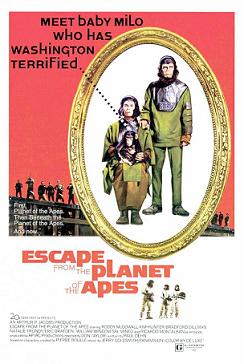
Escape from the Planet of the Apes
Escape from the Planet of the Apes (1971) – It’s not very easy to continue a storyline when the previous chapter ended with the destruction of the entire planet but Fox managed to do it and in a fairly clever, if not obvious, way. Escape opens with an all too familiar style of space craft landing in a large body of water yet again. This time though the silence of the calm ocean waves is broken by the noisy buzz of a military helicopter and it’s quickly revealed that the film takes place in modern times. Just prior to the destruction of their world, chimpanzees Cornelius and Zira accompany the brilliant Dr. Milo (Sal Mineo in another frustratingly brief cameo) for a little joy ride in Taylor’s ship which he had managed to repair. They travel in the opposite direction through the same space warp that landed Taylor in their time and end up, as any dime science fiction novel will collaborate, in his time. Sadly Dr. Milo is killed in the first reel and our two favorite chimps spend the rest of the film trying to avoid sterilization and later execution at the hands of the very Zaius-like human Dr. Otto Hasslein. The incredibly downbeat ending hammers home the point that there is no more place in this world for two talking apes than there was for Taylor in their time but it does provide a very nice set up for their newborn baby, named Milo in honor of their fallen friend, in the next movie.
Budget restrictions were clearly foremost in the minds of the producers of this sequel from the very beginning and the easiest way to cut corners was to reduce the number of complicated ape make ups needed. On the plus side, they kept the best simian characters from the previous films. In retrospect, the limited use of Zira and Cornelius in Beneath almost seems like it was a calculated move to whet the audiences’ appetite for Escape. In many ways Escape excels as one of the best entries in the series, certainly among the sequels, by giving the two likable chimpanzee characters more to do than in any other film. This also makes their senseless and brutal deaths in the final reel that much more dramatic. Escape was the first Apes film to be conscious of its place in the series and begins to lay the groundwork for the story that would play out over the next two installments.
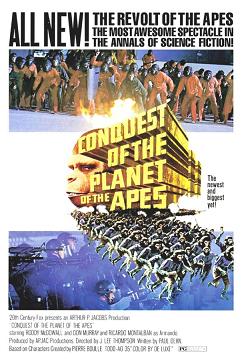
Conquest of the Planet of the Apes
Conquest of the Planet of the Apes (1972) – In the time it has taken Cornelius and Zira’s son, now called Caesar and played by Roddy McDowall who continues with the series, to mature to adulthood, the world has lost all cats and dogs to an interstellar virus and adopted apes as pets. As the simians grow more intelligent from exposure to humans, they are trained as a new slave labor force to serve their human masters in menial positions. When Caesar is exposed to this new order after years of being sheltered, he becomes a fugitive and then infiltrates it as a spy. Finally, after winning the trust of the other apes and setting the stage for a rebellion, he leads the revolt that will turn the tables on the humans and eventually create the planet of the apes seen in the first film.
As with each of the previous sequels, the budget was reduced yet again and while a lot was done with the tragically limited funds, Conquest was the first of the Apes films to be seriously impacted by the tight cash flow. This is most apparent in the climax where an under staffed and poorly armed police force squares off against the same small group of apes (mainly gorillas) filmed from different angles. Sharp eyed viewers will also note a curiously low number of orangutans in this film. The futuristic city is actually a newly constructed shopping mall and works quite well in contrast to the fascist looking government. While a large number of apes were required again for this sequel, by keeping most of them out of close up shots (Caesar was the only ape required to speak) and dressed in generic jumpsuits, the expense was minimized. We also get some great new characters like the intimidatingly creepy Inspector Kolp, played for all he was worth by highly underrated character actor Severn Darden, and the sympathetic African-American MacDonald who sees the parallel between the ape’s plight and those of his ancestors. Conquest was initially saddled with an R rating due to its violent content and Fox insisted it be toned down to a PG. In addition to many small scenes of violence being excised, the original ending was emasculated into an unconvincingly re-dubbed speech from Caesar to justify sparing the humans’ lives.
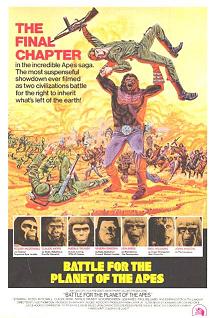
Battle for the Planet of the Apes
Battle for the Planet of the Apes (1973) – Following an off-screen nuclear war, presumably initiated with apes’ revolt, Earth is reduced to a few small pockets of inhabitable surface area and a lot of scorched real estate. In the burned out remains of the city from the previous film, Kolp (now promoted to Governor) leads an irradiated band of humans who cling desperately to what little of their world is left. Meanwhile, Caesar is busy ruling an uneasy conglomeration of apes and humans who are trying to build a new and improved society with limited success. His chief opposition is the gorilla leader Aldo, well played by Claude Akins, who supports military rule and killing humans rather than co-existing with them. After Caesar accidentally tips off the humans to his people’s existence during an expedition to the city, Kolp becomes fixated on revenge at all costs. The final battle is anticlimactic thanks to the budget limitations but the series ends on a hopeful note of humans and apes sharing the planet and rebuilding it as equals.
The ads for the final film in the Apes series promised “the most suspenseful showdown ever filmed as two civilizations battle for the right to inherit what’s left of the earth”. That may have stated the major plot points of the story but the rest of it was wishful thinking! Filmed on roughly the same budget as the previously under funded installment, Battle tried to end the saga with a bang but came out as a muffled thud instead. When the two civilizations finally clash at the climax, the humans are so sickly and ill equipped that it seems amazing that they ever prove much of a threat in the skirmish. Explosions are few, far between, and reused from so many different angles that it gives the viewer déjà vu! Battle initially received a PG rating but Fox, having learned nothing from Conquest, decided to have it cut to a G. The restored director’s cut, which has surfaced in recent years, contains some very interesting footage that ties the humans from the city in with the ones seen in the Forbidden Zone in Beneath and makes the conclusion more satisfying. With the proper budget, Battle could have been the high point of the series but instead it shipped it off in a plain brown wrapper.
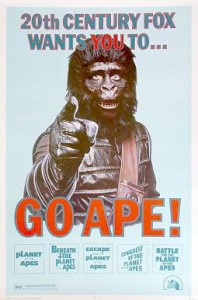 The Planet of the Apes film series is one best viewed as pure entertainment and not analyzed too critically. There is precious little science mixed in with the fiction and the continuity does not hold up well to chronological scrutiny. Aside from some plot holes you could drive a bus through and a few embarrassing effects sequences that were dictated by the reduced budget, the films still hold up well today thanks mainly to the excellent casting of actors who can sell the fantastic roles they play. Whenever someone starts to tear apart the stories with continuity errors and inconstancies, I always remind them of Dr. Hasslein’s presentation on time travel from Escape where he compares the endless alternatives to a freeway with an infinite number of lanes all leading from the past into the future. While the film’s all share a common plot thread, the surrounding history is being rewritten with each installment.
The Planet of the Apes film series is one best viewed as pure entertainment and not analyzed too critically. There is precious little science mixed in with the fiction and the continuity does not hold up well to chronological scrutiny. Aside from some plot holes you could drive a bus through and a few embarrassing effects sequences that were dictated by the reduced budget, the films still hold up well today thanks mainly to the excellent casting of actors who can sell the fantastic roles they play. Whenever someone starts to tear apart the stories with continuity errors and inconstancies, I always remind them of Dr. Hasslein’s presentation on time travel from Escape where he compares the endless alternatives to a freeway with an infinite number of lanes all leading from the past into the future. While the film’s all share a common plot thread, the surrounding history is being rewritten with each installment.
The phenomenon of the Apes didn’t end with the release of Battle. As with most major studio films, the Apes movies were re-released and paired up on double features long after their initial runs were over. Fox went one step further with the Apes films and released all five movies together in Go Ape! marathons. Theatrical films usually took one to two years to turn up on television so the Ape fires were continually burning.
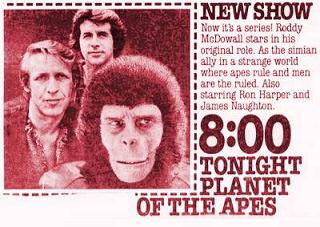
A newspaper advertisement for the premier of the 1974 prime time show
20th Century Fox quickly realized that even though the theatrical film series was over, the public was still hungry for Apes. In 1974, they created a watered down version for television that’s only redeeming factor was casting Roddy McDowall in his third Apes role as Galen. The rest of the series played out like The Fugitive with apes and even though Fox had plenty of props left over from the movies, the series still proved extremely expensive to produce. It was canceled after only three months on television and only fourteen episodes were made. Ten of these episodes were later edited together into five films that were sold into television syndication since the series was too short to sell by itself.
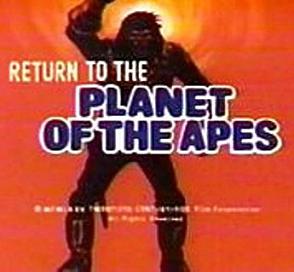
Return to the Planet of the Apes
The following year in 1975, Fox gave it one last try with a Saturday morning television show called Return to the Planet of the Apes. As an animated program, Return was not limited by budget constraints and many of the original ideas from the novel, like the apes driving cars and flying helicopters, were reinstated. The stories were far from great but they were impressive by Saturday morning cartoon standards. Many references were made to other characters from the films and television series but the attempts to modernize the ape society and some misplaced humor fell flat. Like its prime time predecessor, Return was canceled after only one season and a mere thirteen episodes.
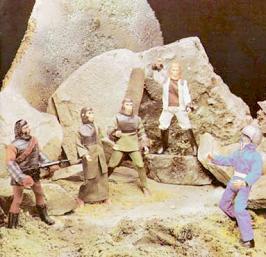
A trade ad for Mego's first wave of Apes action figures
While Fox had been quick on the draw with media projects pertaining to the Apes, they were painfully slow with merchandising. Very few products were made to tie in with the theatrical releases but by the time television was taking over, Ape-mania became full blown. The stand out among the companies producing Ape items was the Mego Corporation. They were best known at the time for their eight inch action figures and the line produced for Planet of the Apes was one of their best. This included figures of almost every prominent ape character from the first film, a generic astronaut, and a nice selection of playsets. For any child that wasn’t into action figures, their local toy store was loaded with Ape posters, puzzles, water guns, coin banks, plastic model kits, and even full size accessory sets that included guns and gorilla masks! It was a great time to be a kid and most of these items have gone on to become prized items among today’s collectors.
I can’t say for a fact if I ever saw Planet of the Apes in theater during its initial release, if I did I was too young to remember. Even though I would have only been four when Beneath came out, I can still recall seeing it first run though and every film that followed it, at least once, in the theaters. As a child, it seemed that for a good five years or so well into the mid-1970’s, there was always something Apes related going on. If the films weren’t being re-released to the theaters, they were being aired on TV or the television series or cartoon show was fleetingly on. My friends and I bought the toys, discussed the movies, and even watched black & white silent 8mm films at the house of any of us lucky enough to have a movie projector. I can’t recall a single series of films that was better loved among my generation than the Planet of the Apes. At least that would be until the late 70’s when Star Wars was released and the pop culture landscape shifted again!
